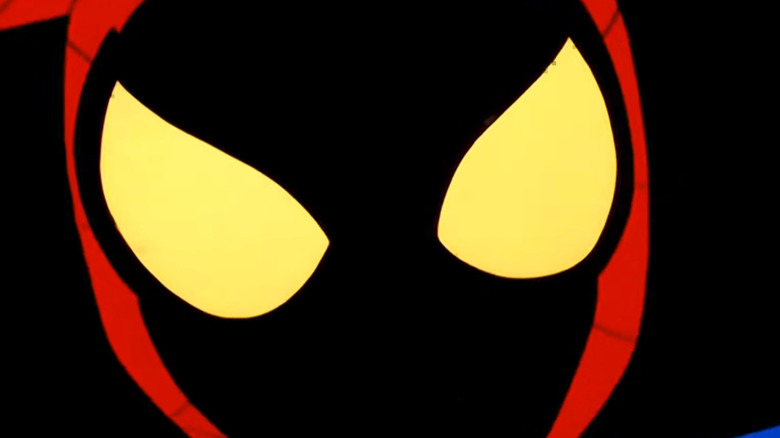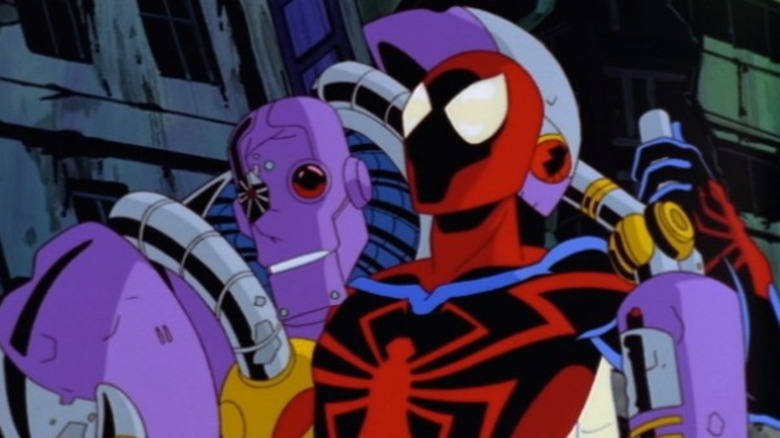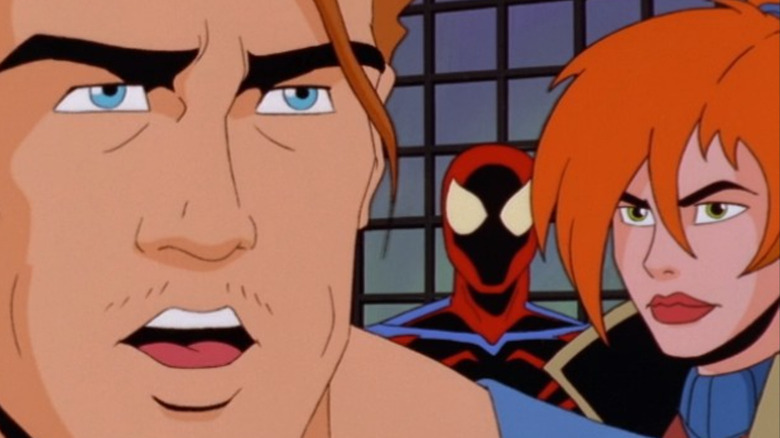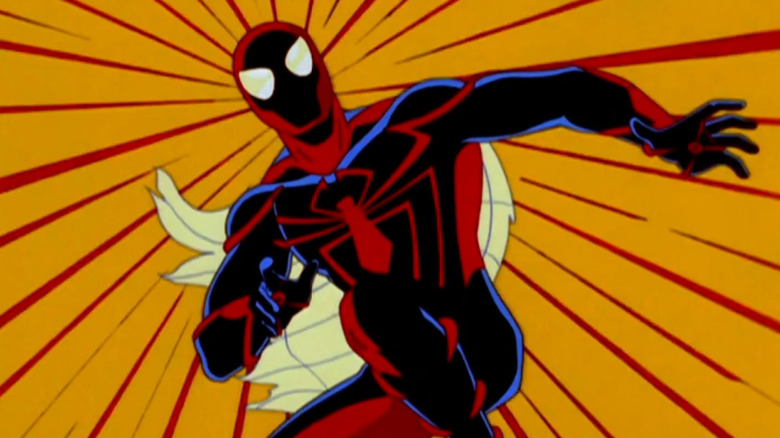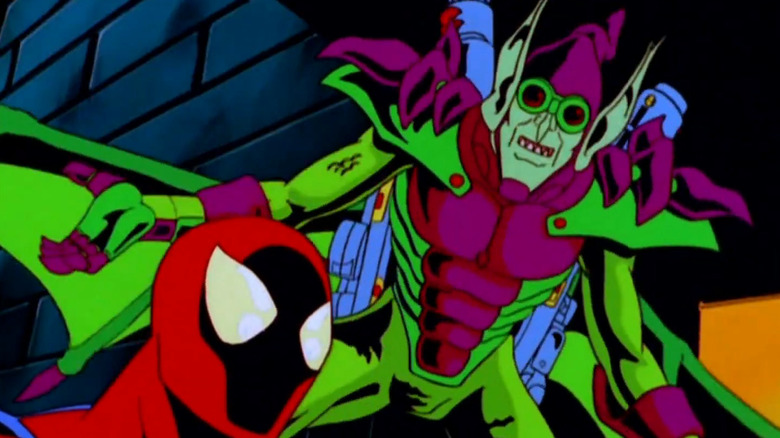The Underrated Spider-Man Series You Should Be Watching On Disney+
Whether you're the biggest webhead on the block or the world's most terrified arachnophobe, there's no denying that Spider-Man is everywhere. The wall-crawler has been featured in comics since his debut in Marvel's "Amazing Fantasy #15" all the way back in 1962, and has since become one of the most enduring comic book characters to ever exist. Nowadays, there's more Spidey out there than you can spin a web at — from countless comics to thrilling video games adaptations, to billion-dollar movies to even a stage musical, Spider-Man has swung his way into every corner of pop culture, and no matter how much the likes of Doctor Octopus and the Green Goblin might want to kill him off, there doesn't seem to be any end in sight.
Another avenue the character has excelled in has to be animation. From the ultra-low budget 1967 "Spider-Man" cartoon to the 2018 Oscar-winning animated feature, "Spider-Man: Into the Spiderverse," there's no shortage of entertaining animated Spidey escapades. However, with all the well-known animated adaptations out there, there are some that have slipped through the cracks that many modern day fans of the character might be unaware of.
In particular, one of the most obscure Spider-Man cartoons is a strange, otherworldly sci-fi series from 1999 that's far better than it gets credit for.
Spider-Man Unlimited is a standout Spidey show with a unique angle
Following the conclusion of the beloved 1994 "Spider-Man" animated series, "Spider-Man Unlimited" was born. The show follows Spider-Man as he travels to Counter-Earth, another Earth located on the opposite side of the sun, to save John Jameson, the son of J. Jonah Jameson. The web-head learns of a battle between a band of freedom fighters and human-animal hybrids that reign supreme on the planet. Spider-Man stays off-world to help in the fight.
The show came into being because of rights issues. When first conceived, Saban Entertainment wanted their series to be a more mainstream Spider-Man tale, but because Sony had already secured the rights to the character's comic book characters and storylines for the purpose of releasing their own series to tie into the then-upcoming "Spider-Man" film by Sam Raimi (per Comic Book Resources), the creative team had to find a way to use the character without almost any of his usual surroundings. To that end, after very briefly considering a Spider-Man 2099 adaptation (an idea that was dropped since it would've been too similar to "Batman Beyond"), it was decided to propel the webhead on an adventure unlike anything he'd ever appeared in before.
In an interview with Another Universe, the head of Marvel's animated shows at the time, Rick Ungar, comments that the reason the show was canceled was due heavy competition with shared slots with the far-more popular "Pokemon." As a result, "Spider-Man Unlimited" was canceled after only 13 episodes, ending on a cliffhanger.
Today, it is largely forgotten and those who do remember it don't look at the series too highly, as evident by its rotten 50% score on Rotten Tomatoes. However, real-life aspects aside, the series is far more interesting than you may remember.
Spider-Man Unlimited helped usher in a multiverse concept
In another interview with Another Universe, Roland Poindexter, Fox Kids Vice President and Head of Programming at the time, discussed the idea behind the Counter-Earth concept. "This Counter Earth is not really a parallel earth," says Poindexter. "It was a planet that was created in our Earth's image. It was created by the High Evolutionary, who is very familiar with our history and our way of life. In some cases our Earth is mirrored. In other cases, it wasn't. He basically copied what he felt was needed from this world and did his own with what he felt was the least desired."
Nowadays, the idea of different universes, dimensions, and earths are dominating our movie screens, especially as far as Spider-Man is concerned. The acclaimed animated feature, "Spider-Man: Into the Spiderverse," as well as the 2021 Marvel Studios hit, "Spider-Man: No Way Home," brought Peter Parker and friends in contact with a wide array of differing worlds that featured their own versions of Spider-Man and his adversaries. Even in non-Spidey comic book movies such as 2022's "Doctor Strange in the Multiverse of Madness," and 2023's "The Flash," the multiverse concept is being explored in new and exciting ways.
While what "Unlimited" crafted may not be quite the same, it nevertheless showed that Spider-Man wasn't just limited to swinging through buildings in New York City, and in that regard paved the way for future depictions — most notably "Avengers: Infinity War," where he is (again) in a new costume and crawling around on another planet.
The animation was stunning
Probably the most acclaimed aspect of the show was the series' striking visual style. In a Reddit thread started by user HebrewWolfman asking commenters about their thoughts on the cartoon, most were quick to praise the show's distinct look. User IAmATroyMcClure says "I actually really loved this show [...] What really got me to appreciate the show was the art style. I've never seen a cartoon with such comic-like art [...] They did such a good job at emulating the inking in comic books in a way that didn't look awkwardly animated. It gives it the perfect "noir" look, too."
Just as the premise called for a drastically new version of Spider-Man and his adventures, so did the way that these elements were depicted. The show's production design, provided by Shanon Denton, was unlike anything ever seen for a Spider-Man cartoon. Full of harsh shadows, detailed characters, and a futuristic aesthetic to its other-worldly elements, the series pushed the bar regarding how Spider-Man could be depicted in animation, creating visuals that were far more artistic than those of the 1990s series that preceded it.
Roland Pointdexter, in his interview on Another Universe, says, "Spider-Man's more moody, darker and detailed. The reason is the subject matter is more complicated and darker [...] this Spider-Man looks completely different from the previous show, as well as any other version of Spider-Man that television has ever been on the air. It's much more sophisticated."
Different interpretations of the characters
With a reimagined world and visual style for Spidey to explore came a set of reimagined characters that came along for the ride. Peter Parker remained more or less the same, although his alter-ego received a new look, which more closely resembled the costume of Miguel O'Hara's Spider-Man 2099 than anything Peter had (at that time) worn in the comics.
More drastically updated were some of the classic Spider-Man foes. Venom and Carnage are here depicted as getting along and willing to work with one another — brotherly, even. The symbiotes here also have more control over their hosts, Eddie Brock and Cletus Kasady. This dynamic is drastically different from these characters are usually approached, as they are traditionally mortal enemies. Even more bizarre is Counter-Earth's version of Spider-Man's arch nemesis, the Green Goblin, who here is actually one of the good guys. More specifically, he is Hector Jones, the ex-husband of Dr. Naoko Yamada, who uses this persona to aid in the rebellion. Although he does become more hostile when he learns that Peter has been residing with Yamada, he is mostly good throughout the show. The Vulture also appears as an ally, with an entire episode dedicated to Spider-Man teaming up with him.
In the world of over-saturated Spider-Man content that could be accused of feeling very samey, "Spider-Man Unlimited" takes the character to fresh, drastically new places that still manages to capture the good ol' Spidey spirit. While it may not be a show for everyone, it's a show that every Spider-Man fan should see at least once.
All 13 episodes can be streamed on Disney+.
